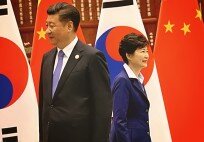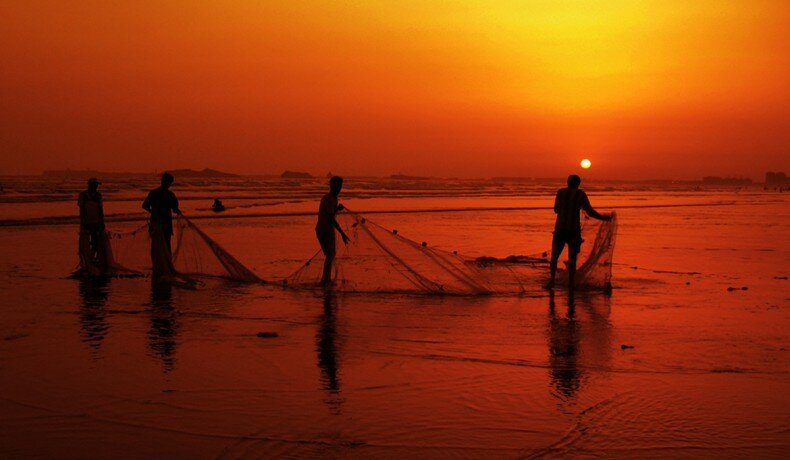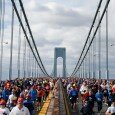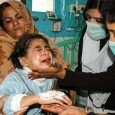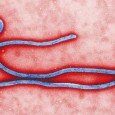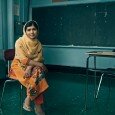By Haroon Janjua –
How Climate Change and Urbanization Are Playing Havoc with Sindh’s Coastal Belt
Rocking waves of tides strike the coast beneath the sweltering sun and a string of fishermen’s boats line the docks. Ibrahim Haideri describes the shanties and deplorable, squalid conditions of the colony of the fishermen. The fishermen were engaged in varied activities, from landing their boats into the sea, and working the long nets, which is what their fishing gear still comprises of a relic of the past, still helping men to live off this primitive mode of subsistence. The skanky odor, polluting the atmosphere to the alleyways of vast slum dwellings, this centuries old domain leaves a visitor sick in the guts. Home to nearly one million people with 90 percent of the population living off fishing.
Women like in many other sectors deemed cheap labor and are unpaid, traumatized, harass and humiliated by all means in terms of their labor rights. Being uneducated and unskilled working under scrimpy payments with too many children till they knuckle under deluging needs. Lack of basic necessities primarily health can be such fatal that could add another datum in maternal mortality or hardly living to see their children trapped in viscous cycle of poverty. Currently, nearly half million people are directly engaged in fishing in Pakistan while another half million in adjunct diligences.
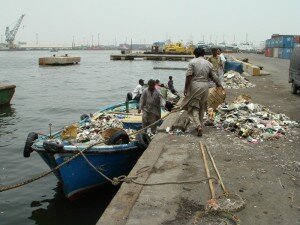 In fisheries industry there are no working hours set. Whenever the catch arrives women are called to perform their duties. The shrimps perish quickly and peeling has to be done early to avoid loss. During the season of maximum catch these women work continuously 14 to 15 hours daily. Without any formal training women workers are involved in making fish baskets, weaving nets and cutting and peeling as a wage workers. According to UN-Women, in 2008, latest available figures globally 44.9 million people were employed in capture fisheries or in aquaculture, at least 12 per cent of whom were women.
In fisheries industry there are no working hours set. Whenever the catch arrives women are called to perform their duties. The shrimps perish quickly and peeling has to be done early to avoid loss. During the season of maximum catch these women work continuously 14 to 15 hours daily. Without any formal training women workers are involved in making fish baskets, weaving nets and cutting and peeling as a wage workers. According to UN-Women, in 2008, latest available figures globally 44.9 million people were employed in capture fisheries or in aquaculture, at least 12 per cent of whom were women.
“Labors primarily women working in fisheries industry are neither recognized nor have government set certain policy to deal with labor issues of this industry,” says Zubaida Birwani Executive Director Trust for Conservation of Coastal Resources (TCCR). Focusing on the indigenous women of fishing community Zubaida added. “Water pollution has caused huge harm to the fish, hence they moved from shallow water to deep sea affecting livelihood and while chasing a big catch the fishermen go far away and cross water boundary where no parameters are set and jailed in India.”
In an offer to help the fisherwomen group to get extraordinary technical skills, compulsory for getting employment in the angling business, TCCR with ILO trained fishermen and fisherwomen for better livelihood options. Fishing is the only source of livelihood in the coastal area of Ibrahim Haideri hence the question of survival seems serious for these vulnerable women.
“I had never seen a Rs 5000 note, let alone hold one in my hands,” says Hameeda Hasan. She has been Paid Rs 250 from 8 AM to 5:00 PM but she can make Rs 350 overtime work for extra four hours till 9:00 PM.
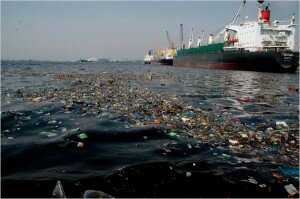 In her early 20s, Hameeda is one of the first girls in her family as well as her neighborhood to have stepped out of the confines of her house for work. “Now at least there is money for medicine. When my younger brother fell ill, we were able to afford to take him to a doctor. Earlier, my mother could barely think of it,” she says, the pain and relief mixed in her voice bear testament to how her contribution to the meager family income is making a difference where it counts the most.
In her early 20s, Hameeda is one of the first girls in her family as well as her neighborhood to have stepped out of the confines of her house for work. “Now at least there is money for medicine. When my younger brother fell ill, we were able to afford to take him to a doctor. Earlier, my mother could barely think of it,” she says, the pain and relief mixed in her voice bear testament to how her contribution to the meager family income is making a difference where it counts the most.
A resident of Ibrahim Hyderi, a coastal village on the outskirts of Karachi, she lives in a partially constructed two room house with her parents and five siblings.
Education having never chanced to cross her path and a female in what is still a largely patriarchal society; Hameeda didn’t have much going in her favor. Like other girls in her community, she too was ‘hanging around till a decent proposal came’ along and she would start her life anew.
Little did she know that by signing up for the fish processing training she would not only be able to help her family which was struggling to make ends meet, but have her sick brother treated by a doctor rather than the corner quack.
The daughter of a fisherman, Hameeda says: “There were times when things were pretty difficult, especially when the fishing season is off. We hardly had two meals. My father tried his best but there’s not much he or the other men in the family could do.” Her mother used to weaved fishing nets to supplement the family’s income, “but the failing business did not help much given that the nylon nets are far sturdier than the handmade ones.”
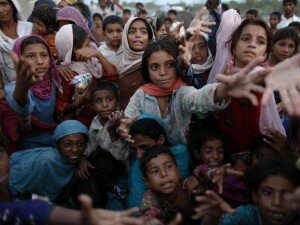 It is under these circumstances that opportunity knocked on Hameeda’s door. “When the social mobilisers came to my house and gave a briefing, I became very interested in the idea of training and working in a proper job. But my father wasn’t keen on the idea,” she says, reminding of the conservative nature of Hameeda’s family, and of perhaps every other family in the neighborhood.
It is under these circumstances that opportunity knocked on Hameeda’s door. “When the social mobilisers came to my house and gave a briefing, I became very interested in the idea of training and working in a proper job. But my father wasn’t keen on the idea,” she says, reminding of the conservative nature of Hameeda’s family, and of perhaps every other family in the neighborhood.
Hameeda insisted that her father allow her to attend the trainings. And after a lot of pestering, coaxing and promises, he finally gave in. Though hesitant at first, when Hameeda and her fellow batch-mates first entered the factory, she says they had a great time ‘learning and earning’.
Climate change is another factor affecting the fish production directly affecting livelihood patterns of the fishermen community. Over the years the piles of the waste material is visible in the forms of larger heaps on the sea coast of Ibrahim Haideri. The mangroves which were seen in abundance near coastal belts are speedily vanishing by urbanization and population settlement impacting aquatic life heavily.
“The adverse effects of rising sea water levels leading to salt water intrusion into large swatches of previously fresh water-fed agricultural land, the continuing contamination of the coastal waters through the dumping of untreated sewage and industrial affluent increasing in ocean toxicity, to culminate in the displacement and distress of tens of thousands, if not millions of people whose livelihoods, health and well-being are directly damaged. Urgent actions are required at multiple levels,” said Javed Jabbar, a veteran social worker.
“Due to increasing water pollution and industrial waste some fish species have migrated into the deep waters as the warm water in coastal is not fit for their survival,” said Mustafa Gurgaze, Program Manager Livelihood Pakistan Fisherfolk Forum (PFF). “Respiratory diseases in the coastal belt are increasing due to pollution and water contamination. The earnings of small fishermen and fisherwomen are decreasing because of fish migrations moreover; with the boats and nets on rent these small fishermen without insurance of lives have no life jackets are causing deaths.”
Urbanization on the other hand is grabbing coastal land in the name of development. From the last decade Karachi’s notorious nexus of land mafia started a campaign of land reclamation from coastal areas by dumping trash onto Ibrahim Haideri’s clean coastline. The fisherman domain is limited, once there were shallow waters it has dried now, the mangroves are vanished and replaced by Defense Housing Authority (DHA) and the elite living in DHA’s are complaining about the smell of fish. This old age livelihood method is being narrowed by the authorities adding extreme sufferings to poor people attached with this profession.
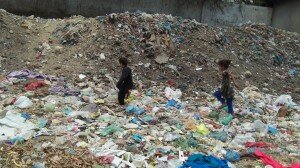 “This was the model fishing village,” says Ayub Shan a veteran activist with PFF. “I remember all sorts of Fish were available earlier, but the growing population and urbanization causing depletion in fish production because of contaminated ecosystem.” He recalls.
“This was the model fishing village,” says Ayub Shan a veteran activist with PFF. “I remember all sorts of Fish were available earlier, but the growing population and urbanization causing depletion in fish production because of contaminated ecosystem.” He recalls.
Ayub Shan, central information secretary with PFF informed, “Millions gallons of contaminated water, pollutant material and industrial waste are dumped in the sea every day. There were 200 islands in 1890 along the coastal area of the Sindh now only 40 remaining.”
“The incremental rise in average temperature in the range 0.6-1°C corresponded by incessant rise in sea levels at 1.2mm (approximate) per year along the coastal areas over the last five decades. It is subsequently been responsible for huge changes in weather patterns along these areas. These have had consequences in increased frequency of wind storms and tropical cyclone with amplified magnitudes. This clearly lays out warnings of even greater damages in future” Said Zubair Siddiqui, Pakistan Meteorological Department, Karachi.
Pakistan’s demographic trends show rapid urbanization with an average annual increase rate of 4 per cent since 1951. By the year 2030, Pakistan will be preponderantly more urban with 45.6 per cent of its people settled in urban areas. It is estimated that 12 cities will comprise over one million people. Experts believe that with estimated population of 23.7 million currently Karachi is the third largest city of the world by population and expected to become world’s most populous city next year. Rapid growth in Karachi aggravated environmental challenges and the administration is struggling to ameliorate infrastructure, sanitation and coastal management.
![]() The writer is a freelance journalist. He tweets @JanjuaHaroon
The writer is a freelance journalist. He tweets @JanjuaHaroon




















































